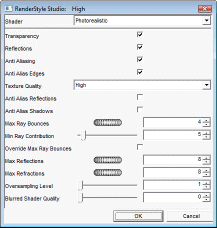Photorealistic
Home > 30 Render > Render Styles Standard > Photorealistic
Photorealistic
Photorealistic shaded rendering style (automatically selects between scan-line and ray casting algorithms depending on anti-aliasing settings).

Transparency: Enables/disables handling of transparency.
o Default : On.
o Range: On / Off
Reflection: Enables/disables handling of ray-traced reflections.
o Default :On.
o Range:Off / On.
Anti aliasing: Enables/disables all the forms of anti-aliasing controlled by the arguments "anti alias edges", "texture quality", "anti alias reflections" and "anti alias shadows".
o Default :Off
o Range:On / Off
Anti aliasing edge: If true, the edges of geometry will be anti-aliased when they are rendered. Note that this argument will be meaningless if the master "anti aliasing" argument is false.
o Default :Off.
o Range:On / Off.
Texture quality: If 'high', anti-aliasing will be enabled for textures and material shaders which support analytic anti-aliasing. The default setting is 'low', which means that no texture anti-aliasing will take place. Note that this argument will be meaningless if the master "anti aliasing" argument is false.
o Default :Low
o Range:Low / High
Anti aliasing reflaction: If true, reflected and refracted textures will be anti-aliased when they are rendered. Note that this argument will be meaningless if the master "anti aliasing" argument is false.
o Default :Off.
o Range:On / Off.
Anti aliasing shadows: If true, the edges of shadows will be anti-aliased. In fact setting this argument to true switches over to the most complete form of anti-aliasing. This also means that, for example, the edges of reflected/refracted geometry will be anti-aliased. Note that setting this argument will effectively override all other anti-aliasing arguments (except for the master "anti aliasing" control which will override this one) by using a ray casting rather than scan line algorithm. A side-effect of this is that multi-threaded rendering only works with this argument set.
o Default :Off
o Range:On / Off
Max ray bounces: Controls the depth of ray tracing if this is used during renders. The smaller the ray depth the faster ray tracing will be for complex scenes, but if the value is set to be too small then effects such as multiple reflections may not be rendered correctly.
o Default :6.
o Range:0 - +Infinite.
Min ray contribution: Controls the minimum contribution that can be made by a secondary ray (reflected, refracted or alpha ray) before it is ignored. A value of 5 means that if the traced ray would contribute less than 5 percent to the total illumination at the pixel of interest then we ignore its contribution.
o Default :5.
o Range:0 – 100.
Override max ray bounces: Enable/Disable the following two controls. If disabled (the default) then all ray depths are the same as "max ray bounces".
o Default :Off.
o Range:On / Off
Max reflection: Controls how many levels of reflection to consider during renders. The smaller the number of reflections, the faster ray tracing will be for complex scenes, but if the value is set to be too small then any multiple reflections may not be rendered correctly.
o Default :3.
o Range:0 - +Infinite
Max reflection: This argument is the same as "max reflections", but
applies to refracted/alpha rays.
o Default :3.
o Range: 0 - +Infinite
Oversampling level: Allows very simple, brute force anti-aliasing to be applied to the renders. Setting this argument to a value greater than 1 will result in over-sampling (or super-sampling) of each pixel will be carried out. In effect this means that the color of each pixel is calculated many times and then an average color calculated. The actual number of samples taken for each pixel is equal to the square of the value of this argument, so there will be a noticeable effect on rendering speed if this argument is increased.
o Default :1.
o Range:1 – 16.
Blurred shader Quality: A global control over the quality of blurred reflections produced by shaders like 'blurred mirror' and 'blurred glass'.
Note that you can override this global setting on a per-material basis using the blurred shaders' own arguments (the quality can either be specified here, via the shaders' own quality argument, or by a combination of the two).
The reflection is made smoother with higher values for the overall quality, such as 1.0. Low values, such as 0.01, lead to a noisy appearance. If the quality is 0, no blurring occurs.
o Default :0.0
o Range:0 .0 - 10.0
|
|